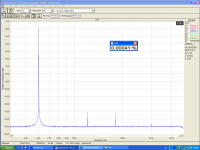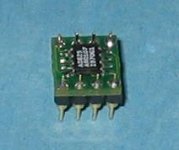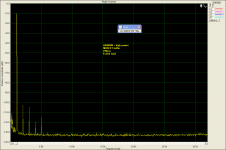Samuel Groner 'OPERATIONAL AMPLIFIER DISTORTION' pp. 59-62. No wonder that you add an output stage to this op amp. It can't drive its own feedback loop resistors, and still get low noise performance. So the trade off is: input dynamic range vs noise vs distortion.
Unacceptable as a stand alone device.
Unacceptable as a stand alone device.
For the record, my input load is about 820 ohms at high frequencies, the output stage of the op amp cannot be completely 'starved' or it will not work in this phono circuit.
Now I remember why I didn't audition this part: The package was NOT mini-dip, and the board was designed for mini-dip more than 1 year ago.
Yes, SMD only. I use these adapters for fast testing purposes:
Attachments
For the record, my input load is about 820 ohms at high frequencies, the output stage of the op amp cannot be completely 'starved' or it will not work in this phono circuit.
This should be OK, hopefully. Anyway, I have good experience with opamp output buffering just for the application in a phono preamp - to drive equalization network.
You know, PMA, the REAL problem lies with ADI. Perhaps we can get Scott Wurcer to explain why the output stage cannot drive 600 ohms without excessive distortion. How can we use it WITHOUT an external output stage? A single extra milli-amp might have made it relatively OK. Then maybe not. I'm all for discrete, at this point.
Well, now I have to take it all back (maybe) because SG measured the AD8599 and NOT the ADA4898-1. So I have to retract my criticism of this part until it is proven one way or another, BUT the ADA4898-1 DOES HAVE HIGHER QUIESCENT CURRENT than the AD8599 (7.5ma vs 5.7ma) so there is the missing output current, I would think.
Samuel Groner 'OPERATIONAL AMPLIFIER DISTORTION' pp. 59-62. No wonder that you add an output stage to this op amp. It can't drive its own feedback loop resistors, and still get low noise performance. So the trade off is: input dynamic range vs noise vs distortion.
Unacceptable as a stand alone device.
I am sorry, but I have the LT1115 at these pages. No ADA4898 in this book. Maybe I have an older issue of the book.
But there is an OPA2132/2134 in the book (page 184-6). And it has big problems to drive 600 ohm load, and also has poor common mode linearity and output linearity even for 2.2 kohm load.
Attachments
Last edited:
Well, now I have to take it all back (maybe) because SG measured the AD8599 and NOT the ADA4898-1.
Thanks for correcting yourself. You have made me very confused, indeed, as we have a plenty of measurements with this part (ADA4898).
You are mixing apples and oranges PMA. The phono system has 2 stages. The first stage would be open to a quiet bipolar IC. However, it MUST be able to drive its own feedback resistors. The LT1028 is also lousy in this respect.
SG apparently has not tried the ADA4898-1 as of yet, so we must infer from similar designs from the same company. Please look at the AD8599, and you will see that it has a problem. Does the 4898 have the same problem? Maybe, maybe not.
My second stage demands a DUAL jfet input op amp. Any better suggestions than the OPA2134?
SG apparently has not tried the ADA4898-1 as of yet, so we must infer from similar designs from the same company. Please look at the AD8599, and you will see that it has a problem. Does the 4898 have the same problem? Maybe, maybe not.
My second stage demands a DUAL jfet input op amp. Any better suggestions than the OPA2134?
No, PMA I need a measurement of the 4898 with a 600 ohm load at 10V out for a direct comparison. Without it, I have to guess.
I have another interesting application of ADA4898. It is a small power amplifier, 4898 + MOSFET power buffer (unity gain buffer). Total gain 27dB. ADA has to drive load impedance of about 2 kohm, and does not seem to have problems with this task.
Attachments
Last edited:
No, PMA I need a measurement of the 4898 with a 600 ohm load at 10V out for a direct comparison. Without it, I have to guess.
I see, but you will have to perform your measurement.
You are mixing apples and oranges PMA. The phono system has 2 stages. The first stage would be open to a quiet bipolar IC. However, it MUST be able to drive its own feedback resistors. The LT1028 is also lousy in this respect.
SG apparently has not tried the ADA4898-1 as of yet, so we must infer from similar designs from the same company. Please look at the AD8599, and you will see that it has a problem. Does the 4898 have the same problem? Maybe, maybe not.
Have you downloaded his latest version? I sent him samples of everything I could get my hands on, but don't remember exactly what now.
BTW us oldtimers have also had to educate the new guys on common mode linearity.
Good morning, Scott
I am not sure why John Curl mentions AD8599 (14V/us, 10MHz), though I have been using ADA4898 (55V/us, 65MHz). I am confused.
Regards,
I am not sure why John Curl mentions AD8599 (14V/us, 10MHz), though I have been using ADA4898 (55V/us, 65MHz). I am confused.
Regards,
Nathan's circuit is patented US6963244 so it is public record. Nathan is one of those new young guys I was telling you about from San Jose State. I introduced him to Jim B. but that was somewhat a disaster.
Yes PMA, John please download and read the datasheet, this part is specified down to 100 Ohm RL and with total feedback circuits down to 500 Ohms, and don't forget the multi-tanh input completely removes Barrie's PIM mechanism here it is identically zero.
Yes PMA, John please download and read the datasheet, this part is specified down to 100 Ohm RL and with total feedback circuits down to 500 Ohms, and don't forget the multi-tanh input completely removes Barrie's PIM mechanism here it is identically zero.
Attachments
Last edited:
- Status
- Not open for further replies.
- Home
- Member Areas
- The Lounge
- John Curl's Blowtorch preamplifier part II




